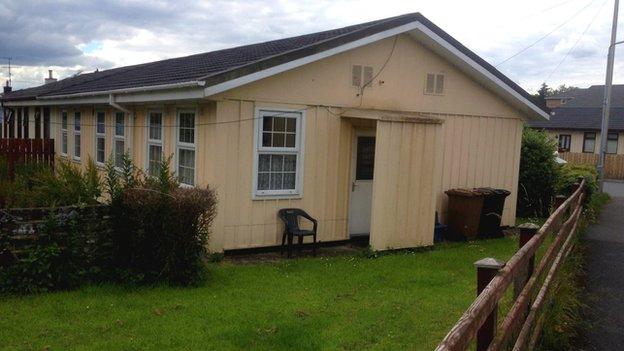Tin Town Kids: Growing up in Northern Ireland's prefab housing estates
- Published

Daires Willows, a post-war housing estate in Armagh, was one of several Tin Towns that were built across Northern Ireland in the middle of the last century
They were envisaged as a temporary solution to the post-World War Two housing shortage, but almost 70 years later, some so-called Tin Towns are still standing the test of time.
About 2,000 aluminium prefab houses were built across Northern Ireland during the late 1940s, to help ease the accommodation crisis.
In Belfast alone, half of the housing stock had been badly damaged when Adolf Hitler launched a series of deadly aerial attacks on the city in the spring of 1941.
For those who had lost their homes in the Belfast Blitz, the government found a ready-made remedy in the form of aluminium bungalows, which were shipped to Northern Ireland from England, external.
Legacy
Rome wasn't built in a day, but many Tin Town houses were, and yet a few still survive to this day in places like Belfast, Armagh, Carrickfergus, Omagh and Bangor.
Over the last seven decades, many generations of children have been raised in the estates - and one of those children grew up to become one of Northern Ireland's leading experts on housing.
.jpg)
Prof Paddy Gray went back to his childhood home in a Tin Town estate in Armagh to assess the legacy of a unique housing experiment
Paddy Gray, professor of housing at the University of Ulster's School of Built Environment, was brought up in Daires Willows, a Tin Town estate in Armagh.
He has revisited his childhood home, as part of his research for a new BBC Radio Ulster documentary called Tin Town Kids.
The programme explores the living conditions provided by prefab estates and assesses the legacy of this unique housing experiment.
'Icicles'
Prof Gray, who presents the documentary, recalls the coldness of the metallic houses but also the warmth of his neighbours and childhood friends.
"There are 20 aluminium bungalows that make up Daires Willows, nestled in the shadow of St Patrick's Catholic cathedral in Armagh," he said.
"All of these are still there today and revisiting the area brought me back to the 1960s and 1970s, to where I spent my formative years."
.jpg)
Daires Willows estate is nestled in the shadow of St Patrick's Catholic cathedral in Armagh
He added: "Thinking back to my days growing up in the Willows I remember the coldness of the houses. In those days there were no carpets but linoleum on the floors.
"There was one open fire in the living room which heated the water but no central heating."
The professor remembers his family throwing their coats over their beds for extra warmth, while the children were given glass lemonade bottles filled with hot water to take to bed, as makeshift hot water bottles.
"In the morning, during the winter you would find icicles on the windows," he recalled.
Although the thin, aluminium walls provided little protection from the cold weather, when the bungalows were first erected, they actually improved living standards for many families.
They came equipped with new kitchens and an indoor toilet - a luxury for some in the post-war period.
.jpg)
Many of the houses had gardens front and rear, providing space for children to play
The prefab developments were a precursor to what are now referred to as council estates, including Taughmonagh in south Belfast and Westrock, in the west of the city, which both feature in the documentary.
Noisy neighbours
In Armagh, the Gray family home had gardens to the front, side and rear, which provided plenty of space for four young "football fanatic" brothers to play.
"The front garden was Wembley and the side Hampden Park," recalled Prof Gray.
"The street lights acted as floodlights. How the adults tolerated this I still wonder, as you could hear everything within the houses and if the ball hit the house at all, pictures would fall from the walls."
Noise was just something the residents had to get used to. The bedrooms of some semi-detached bungalows were built adjacent to the next-door neighbours' bedrooms.
Prof Gray remembers that noises and conversations could be be heard from one house to the other.
"When it rained you could hear every drop on the roof which in many ways made a rain storm very exciting," he said.
.jpg)
Residents found it difficult to heat their homes, as the thin, aluminium walls provided little protection from the elements
The housing lecturer said his personal experience of growing up in an aluminium home gave him "an early awareness of the different house types people live" in and remained a "motivating factor" in his career choice.
'Sense of community'
"Daires Willows was never really called Tin Town by its residents but certainly others referred to it, especially if they wanted to annoy you," he said.
"I had never really understood what it was like to live in a brick house or a house with stairs, as I was very content with what I had as were the other residents."
Returning to his aluminium roots, Prof Gray's said his abiding childhood memory of his own Tin Town is the "sense of community that existed" in the Armagh estate.
He said he hoped the documentary would encourage "conversations about the wide and varied choices of housing, both current and historic, across Northern Ireland".
Tin Town Kids will be broadcast on Sunday, September 21 at 13.05 BST on BBC Radio Ulster, 92-95FM, DAB digital radio, digital TV and online on BBC Radio Ulster.